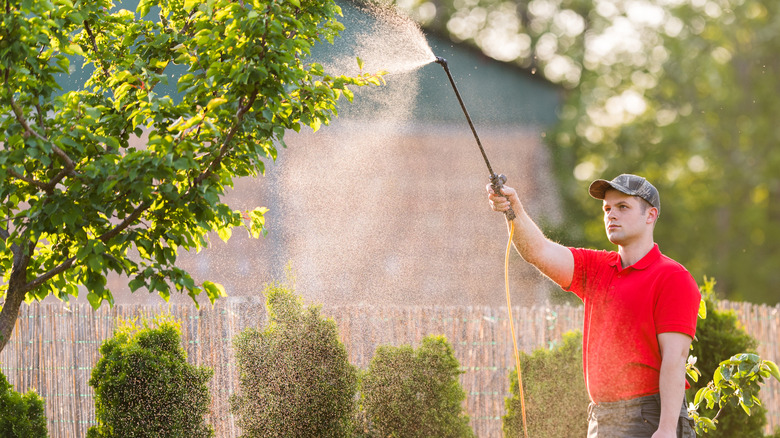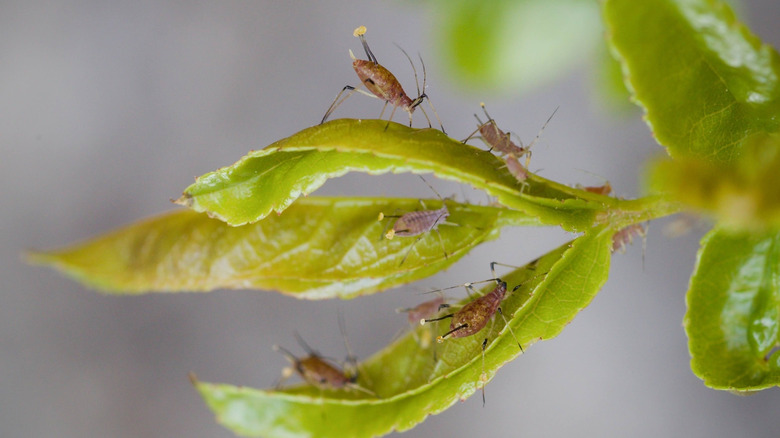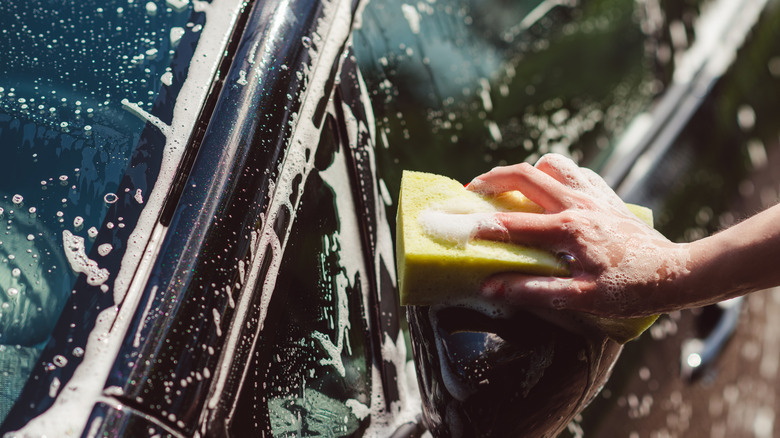The Sticky Substance On Trees In Nevada Yards That's Attracting Pests (& What To Do About It)
Temperatures have been heating up in Nevada, where summer is in full swing; plants are blooming, and pests abound. If you've noticed certain trees in your backyard dripping with a sticky, sap-like substance, you'll likely soon see higher populations of various insects. This sticky residue is honeydew, an excrement produced by pests that feed on your trees and plants. Left untreated, honeydew can go on to grow a black, sooty mold, which stops the plant from photosynthesizing. Honeydew also becomes an irresistible snack for different insects, including ants, wasps, bees, and flies. And, if you're not careful, what began as a minor infestation can end up killing the tree altogether. Not only that, but honeydew can cause a real mess outside of your garden by dripping onto nearby cars, sidewalks, and roofs.
Luckily, there are several ways to treat your plants for honeydew. First, eradicate the pests that produce it; to do this, you can employ methods ranging from pesticides to biological controls and other ways that repel bugs naturally. In the meantime, you can deter the secondary pests that are drawn to the honeydew with a few other tricks, including manual removal of the honeydew from your plants using water and insecticidal soaps. The best approach includes action on all fronts.
How to tackle bugs that produce honeydew
One month you're enjoying new green foliage on your backyard 'Raywood' ash, and the next, the tree is surrounded by ants and wasps. If honeydew is to blame, target the pests who produce it first. Several pests can excrete honeydew, many of them extremely small and difficult to spot at first. Whiteflies, aphids, scale, and adelgids all suck the nutrients out of plants before producing the sticky liquid.
Eradicating these bugs is tricky because they reproduce rapidly and their life cycles are short, meaning just as you kill off the adults, more babies are hatching and growing in their place. Begin by hosing your plants with water. Many adult pests and their eggs can be sprayed off from plants and trees. Next, you'll want to bathe the plant in an insecticidal soap, which is specially designed to be gentle on plants but tough on insects, killing them on the spot. Insecticidal soap will also remove the honeydew itself. You'll have to do several rounds of treatment over the course of a few weeks.
If these methods don't work, you might try a more serious approach with pesticides. Keep in mind that using many of these chemical treatments, including imidacloprid, can be a mistake if you're trying to attract pollinators to your garden, as they can kill beneficial bugs. In fact, there are several downsides to using systemic pest control insecticides in your yard. Regardless of the method you use, once you've eliminated the infestation, you'll be on your way to deterring the honeydew-loving pests as well.
Cleaning up honeydew following a pest infestation
Cleaning up the honeydew left over from an infestation will remove the food source drawing other bugs to your yard, and doing so is simple with the right tools. If the sap remains stuck on trees after your initial insecticidal soap applications, it may still draw ants. In this case, try applying a sticky wrap below the portion of the tree with honeydew; it will trap and kill the ants before they reach the food source.
To remove honeydew from sidewalks or a driveway, start with your hose. You can easily spray concrete to rinse the sap away or use a pressure washer for more stubborn areas. When removing honeydew from your car, you'll want to be more careful, as serious buildup and harsh cleaners can compromise the paint job. Experts recommend washing your car with soap and water, then soaking the honeydew spots with a solvent such as rubbing alcohol before wiping it clean. Meanwhile, you can clean outdoor furniture with a mix of detergent, vinegar, and water.
The sooty mold that often builds up on honeydew should also wash away with gentle cleaners. It's important to remove this residue. Even though it doesn't attract secondary pets, it can kill the affected plant by preventing it from processing sunlight and water. Fruits with sooty mold on them can still be eaten when washed.


